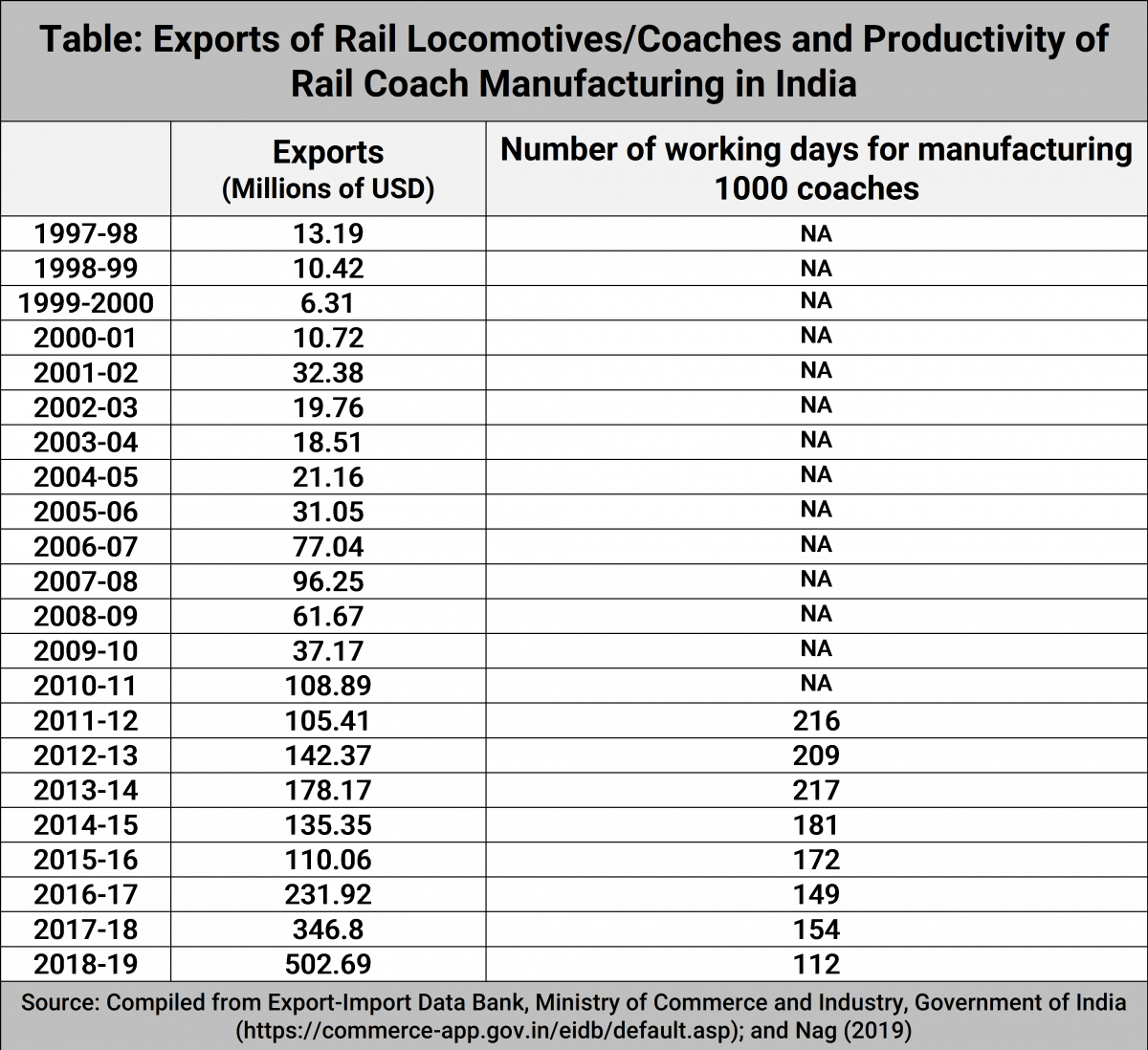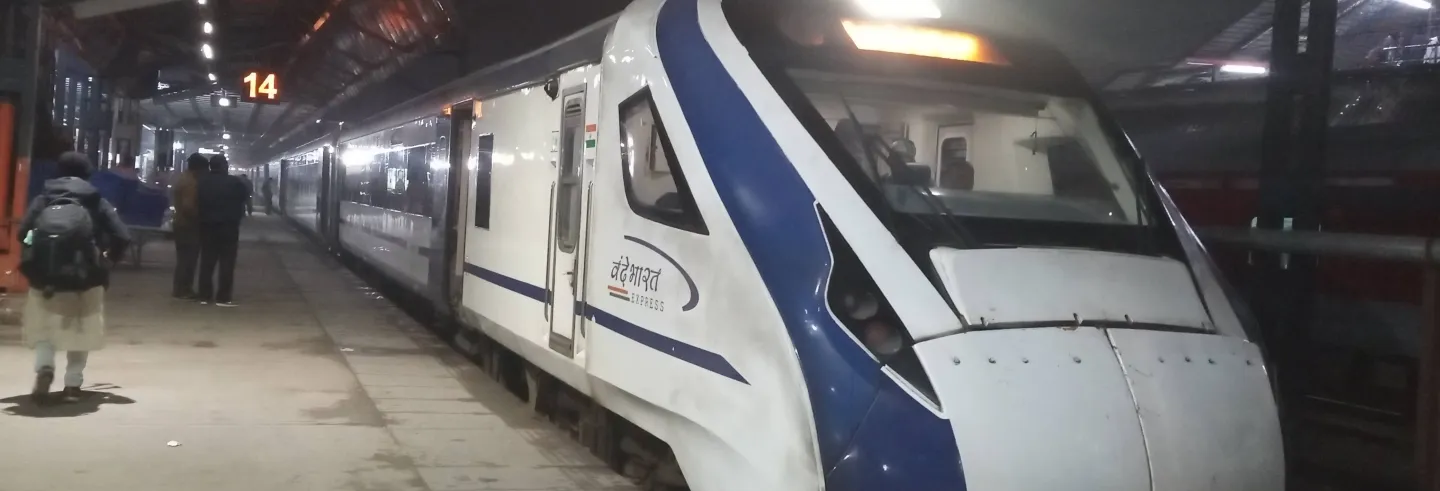India initially followed a policy of growth with technological self-reliance but is now increasingly dependent on foreign technology that comes essentially through multinational corporations (MNCs) and via technology licensing agreements between unaffiliated Indian companies and MNCs. Barring the rare exceptions such as space, the country cannot boast of developing technology through indigenous efforts in high-technology areas such as nanotechnology and semiconductors, where such efforts were mounted earlier. This is despite the fact that the country has a number of very capable public-research organisations in high technology. India’s gross domestic expenditure on research and development (R&D) as a proportion of the Gross Domestic Product (GDP) has been stagnant at around 0.70% since 2012.
An area where India’s indigenous R&D efforts have been very successful is the design and manufacture of railway engines and coaches. Engines are manufactured at the railway production units at Chittaranjan, West Bengal, and Varanasi, Uttar Pradesh. The country’s requirement of rail coaches are met through domestic production at three factories at Perambur, Tamil Nadu; Kapurthala, Punjab; and Rae Bareli, Uttar Pradesh. The coach factories have improved their productivity over time, as measured by significant reductions in the time taken to manufacture coaches. Exports of railway coaches and engines have shown a spike since 2015-16.
Of the three coach factories, the Integral Coach Factory (ICF) set up in Perambur near Chennai in 1955 is the major one as it has manufactured about 50,000 coaches since its inception—the highest by any rail coach manufacturer in the world. It also has state-of-the-art infrastructure to manufacture stainless steel Linke Hofmann Busch (LHB) coaches. At present, ICF is the leader in the manufacture of self-propelled coaches, viz. electric multiple units (EMU), mainline electric multiple units (MEMU), and diesel electric multiple units (DEMU) in the country. However, in the design and manufacture of train sets, which is common in all developed railway systems in the world, India till very recently has been a laggard.
The introduction of an indigenously developed and manufactured train set, the Vande Bharat Express or Train 18, has proven India's design and development capabilities in this important technology (Press Information Bureau, 2019). The Train 18 (named after the year of the launch of the project, 2018) is India's first semi high-speed train. Built at 40% of global prices, Train 18 is capable of clocking 160-200 km per hour (kmph), against the average 50-60 kmph speed of India's express trains.

Given that it took the ICF only 18 months from conceptualisation to manufacturing Train 18, and that, more importantly, 80% of its components are indigenous (Jacob, 2019a), Train 18 has the potential to turn out to be an important showpiece for the Make in India initiative of the government. What embellishes this accomplishment is the fact that the modus operandi for Indian Railways before Train 18 was always to acquire technology from abroad for rolling stock and to assimilate it gradually with the help of the technology collaborator.
However, there were reports (Kumar, 2019) last year that due to a variety of reasons there was a threat of the production of Train 18 coming to a halt at ICF. The experience of Train 18 was beginning to look ominously similar to many other cases of indigenous R&D efforts, where when the domestic R&D project is nearing its logical conclusion, the government allows import of foreign technology supposedly on grounds that the domestically developed technology does not meet some of the standards (often deliberately set high).
The Train 18 project
Train 18 is the first self-propelled train designed and manufactured in India for long-distance inter-city travel. Manufactured at Rs 97.5 crore — less than half the global cost (Dayal, 2019) — this 16-coach air-conditioned train-set project involved conceptual design, detailed design, development and prototype tests of sub-assemblies, and the subsequent supply chain, assembly, and manufacture of the shells, followed by furnishing, testing and commissioning. Since Indian Railways was the developer of the technology, it had to coordinate not only with in-house technical teams but also with vendors who were developing the sub-assemblies. As Indian Railways did not have ready technology for 160-kmph-fit motorised bogies, the team had to develop bogies with fully suspended traction motors and under-slung propulsion systems, with an attractive exterior.
At present two sets of trains, comprising a total of 32 coaches, are in service on the Delhi-Varanasi and the Delhi-Shri Mata Vaishno Devi routes. Their occupancy rates have been 100%, showing their immense popularity among passengers. It was also initially proposed to manufacture a total of 640 train-set coaches in the three years 2019-20 through 2021-22, although there is now some confusion about the actual order that has been given to ICF.
Roadblocks to the Train 18 project
According to initial press reports (Jacob, 2019b), the Train 18 project had hit a roadblock. The government was said to have cancelled the orders for 40 new train-sets with the ICF and had decided to float fresh tenders, although two out of the 40 were already in service.
Three problems were raised regarding the existing train sets manufactured by ICF and put into operation. Firstly, it was stated that the train was overweight. Secondly, as a result, the train set was said to be less fuel-efficient in comparison with other semi high-speed trains running in India. Thirdly, in procuring the components for the train, there were allegations that tendering rules were not followed, and this led to a spate of vigilance inquiries against the A-team that was involved in the design of this train set. The vigilance inquiry was supposed to have been precipitated by allegations of irregularities in the procurement of the propulsion system for EMU/MEMUs (suburban trains) and Train 18.
While the first two problems are technological in nature and can be corrected through a change in the design, the third is procedural in terms of the norms for government procurement supposedly not being followed.
There are examples from the past of stalling an indigenous R&D project conducted in public-sector organisations by instituting a vigilance or corruption enquiry against the top members of a project. In the 1990s, when the union minister for communication wanted to stall the R&D activities of the telecom research unit C-DOT, this was done by ordering a vigilance inquiry against Sam Pitroda, who was heading the R&D project. This completely destabilised that otherwise unique and successful indigenous R&D project in telecom switching equipment (Mani, 2019).
The inquiry against the ICF team was launched in June 2019, following complaints that the Hyderabad-based Medha Servo Drives (MSD) was “unduly favoured” for the project and that the eligibility criteria in the tender were tailored to suit the firm, over MNC suppliers of major propulsion systems, such as Siemens and Bombardier (Mishra, 2019). However, MSD, a manufacturing company established in 1984, is one of the few firms in India that is focused on railway transportation. Over the last 35 years the firm has grown to employ over 3,200 personnel and in 2019 had a turnover of Rs 1,740 crore. The firm specialises in three areas of railway transportation, namely control electronics, power electronics, and safety-critical signalling. The firm is also highly R&D intensive, having set up its in-house R&D centre in 2004. It has exported its railway products to many countries, including the United States.
In 2016, the ICF awarded a contract to manufacture 40 train sets at Rs 100 crore per train set to a Swiss-Indian consortium consisting of Stadler and Medha. The consortium was awarded the contract because it had the lowest quotation in the tender and it also satisfied the other tender conditions of having manufacturing facilities in India as well as having a minimum of five years’ experience in supplying train sets to developed markets (Jha, 2018). MNC manufacturers such as Bombardier and Siemens were offered the opportunity to submit counteroffers, but they are believed to have refrained from doing so. China’s CRRC and the state-owned Bharat Heavy Electricals Limited (BHEL) were among the other bidders in the first round.
After much furore in the national press and strong opposition emanating from the opposition parties—and possibly also from groups within the ruling Bharatiya Janata Party that subscribe to self-reliance—the Railway Board approved, on 16 December 2019, a plan for ICF to manufacture 160, 240, and 240 coaches, respectively in 2019-20, 2020-21 and 2021-22 at its factories (Lok Sabha, 2019). The new rakes will be manufactured on a revised design of the Train 18 model approved by the Research Designs and Standards Organisation of the Indian Railways. These trains will be lighter and more fuel-efficient than the initial sets.
Earlier Episodes of Obstacles
The roadblocks placed in the diffusion of Train 18 are a repetition of similar such attempts in the past to prevent the adoption of indigenous technology. For example the public sector C-DOT was established in the mid-1980s to act as a knowledge-generating lab for telecommunications equipment. The technology developed at C-DOT would be transferred to public and private sector firms. The lab was very successful in developing digital switching equipment for smaller rural exchanges and its presence made the market for switching equipment contestable, eventually leading to a significant fall in the average price of switching equipment (Mani 2005).
During 1989-91, many attempts were made to pare down the R&D activities of C-DOT and a committee was appointed to evaluate the functioning of C-DOT. This committee in 1990 alleged that there had been serious irregularities and time overruns in the large local switch equipment project. Although these so-called allegations were effectively answered by C-DOT, some of the key officials were removed from their positions, destabilising the R&D project. Mani (2019) showed that these efforts could largely be attributed to the machinations of foreign firms whose market in the country was challenged by the availability of C-DOT designed fixed-line switching equipment.
As a result of the constant destabilisation activities, C-DOT soon showed a lack of strategic direction. This manifested itself in the kind of research projects C-DOT focussed on and those it did not focus on. For example, while the technology frontier had moved on to mobile communication technologies, the lab continued to focus on fixed-line telecom technologies. The C-DOT example clearly emphasises the need to stay away from actions that have the potential to harm the indigenous development of technology.
A Successful Model of Indigenous R&D
Over the years, the Indian Space Research Organisation (ISRO) has built up considerable innovation capabilities in four important areas of space research (Mani, 2010) such as: (i) earth observations and remote sensing; (ii) satellite communications and navigation; (iii) space science and environment (Chandrayan-1 and -2); and (iv) launch vehicles (PSLV, GSLV). Among the four areas of considerable technological capability, two areas where the country has an undisputed leadership are remote sensing and the design and manufacture of satellite launch vehicles. Throughout its existence, ISRO has had to deal with many failures, but the state has always strongly supported it. Given the possibility of dual-use, ISRO could never hope to get any technological support from other spacefaring foreign countries. Therefore, ISRO’s foray into unknown and complex technologies with a fair amount of success is perhaps one of the few examples of successful organisation and development of indigenous R&D in India.
Baskaran (2001) and Mani (2010) have attributed the relative success of ISRO to three main reasons. First, the nature of the organisation itself has been important, which meant that there was very little interference by the government in ISRO’s R&D activities. This was ensured by the fact that the head of ISRO and the secretary to the Department of Space are the very same person, and they have always risen from within ISRO, thus possessing a fair amount of inside knowledge of the organisation. Second, the government has consistently funded its R&D essentially through grants. Space research has always received the second-largest amount of funds, after defence research, for R&D (Department of Science and Technology, 2018). Third, even when some of the satellite launches have ended up as costly failures, the government has continued to support ISRO with steady R&D funding. Moreover, ISRO has also, as a result, institutionalised the process of learning from past mistakes and then growing from strength to strength.
The case of space research thus shows indigenous R&D projects can succeed and bear useful results.
Conclusions
The cost of development and reliability of Train 18 indicate that India may finally have designed and developed a product matching international standards. Given the importance of railways to the economy, Train 18 has the potential to provide a fillip to the Make in India initiative. Also, it is a more cost-effective solution than having costly bullet trains between Indian cities. The history of technology development in India shows the need to not only support the adoption of indigenous technologies but also to stop putting roadblocks in the development of homegrown technologies. We must learn from our past and allow manufacturing technologies of the type of Train 18 to flourish.










